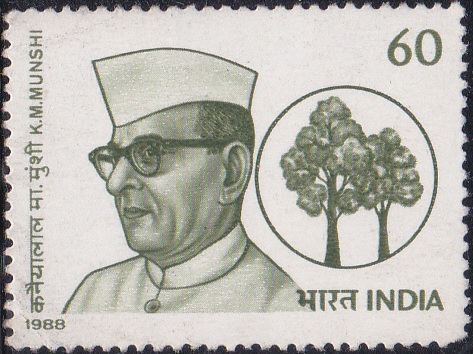
K.M. Munshi
A commemorative postage stamp on the Birth Centenary of Kanaiyalal M. Munshi, founder father of Bharatiya Vidya Bhavan :
 Issued by India
Issued by India
Issued on Dec 30, 1988
Description of Designs : The stamp depicts K. M. Munshi and a tree, symbolising his interest in the Van Mahotsav. The first day cover shows him against a background of the Bharatiya Vidya Bhavan. The stamp is designed by India Security Press, Nasik Road, the first day cover by Sankha Samanta and the cancellation by Alka Sharma.
Type : Stamp, Mint Condition
Colour : Single Colour
Denomination : 60 Paise
Overall size : 3.91 x 2.90 cms.
Printing size : 3.55 x 2.54 cms.
Perforation : 13 x 13
Paper : Imported un W/M H.S. 2 coated gummed stamp paper
Number Printed : 10,00,000
Number per issue sheet : 35
Printing Process : Photogravure
Printed : India Security Press
Name : Kanaiyalal Maneklal Munshi
Born on Dec 30, 1887 at Broach, Gujarat, India
Died on Feb 8, 1971 at Bombay, India
About :
- K.M. Munshi is remembered for his versatility: freedom-fighter, lawyer, one of the makers of India’s Constitution, literary giant, philosopher, creative artist, educationist, promoter of art, music, dance and drama, an able administrator, an advocate of Sanskrit and Hindi, environmentalist and a builder of institutions.
- Born in Broach (now in Gujarat State) on 30th December, 1887, he settled down in Bombay in 1901. He was deeply influenced by Shri Aurobindo Ghosh, who was his Professor at Baroda College. He married Atilaxmi Pathak when he was 14.
- Lawyer by profession, he was enrolled as an Advocate (O.S.) in 1913 and joined the Home Rule League and became Joint Editor of Young India. In 1917, he became a member of the Subjects Committee of the Indian National Congress.
- Dr. Munshi was deeply interested in education. He was elected President of the Panchgani Education Society and founded the Gujarati Sahitya Sansad. He was closely associated with the Bombay University in different capacities. The Maharaja Gaekwad of Baroda appointed him a Member of the Baroda University Commission.
- In February, 1924 his wife, Atilaxmi, passed away. In 1926 he married Lilavati Sheth.
- In 1927 he was elected to the Bombay Legislative Council, but resigned in 1929 during the Bardoli Satyagraha. He was re-elected in 1930. He rejoined the Congress and was sentenced to six months’ imprisonment for participating in the Salt Satyagraha movement. In 1932 he was sentenced to two years’ rigorous imprisonment in Bijapur. In 1934 he was re-elected to the Bombay Legislative Assembly and appointed Home Minister in the first Congress Government. He was elected President of the Gujarati Sahitya Parishad.
- In 1939 he resigned the Home Ministership, plunged into the Satyagraha movement and was again arrested.
- In 1946 he was appointed to the Experts’ Committee for drafting the Constitution of India and elected to the Constituent Assembly. In 1947, he was appointed Agent-General to the Government of India in Hyderabad. In 1950, he became the Union Minister for Food & Agriculture, and was the Governor of U.P. from 1952-57.
- He resigned from the Congress in 1959 and was elected Vice-President of the Swatantra Party.
- In 1938, Shri Munshi founded the Bharatiya Vidya Bhavan at Bombay, and, as its President, guided its activities till his death. He transformed the Bhavan into a major institution serving the cultural, educational, literary, scientific and spiritual life of the nation through its innumerable activities. It has now over 85 constituent institutions and 50 Kendras.
- His love of literature was such that even when he was young, he promoted a monthly magazine – BHARGAVA. He wrote over 125 books, including social, mythological and historical novels, in English, Hindi & Gujarati. He is considered one of the path-breakers of Gujarati literature. His books include ‘Mari Kamala‘, ‘Vami Vasulat‘, ‘Kono–Vank‘, ‘Patan–ni–Prabhuta‘, ‘Gujarat–no–Nath‘, ‘Prithvi Vallabh‘, ‘Rajadhi Raj‘, ‘Kakani Shashi‘, ‘Gujarat & Its Literature‘, ‘I follow the Mahatma‘, ‘Akhand Hindustan‘, ‘The Glory that was Gurjaradesa‘, ‘Imperial Gurjrars‘, ‘Bhagvadgita & Modern Life‘, ‘Gandhi, the Master‘, ‘The End of an Era‘, ‘Krishnavatara‘.
- Dr. Munshi is rightly ranked among the great architects and builders of modern India. He died on February 8, 1971.
- Text Courtesy : Bharatiya Vidya Bhavan.



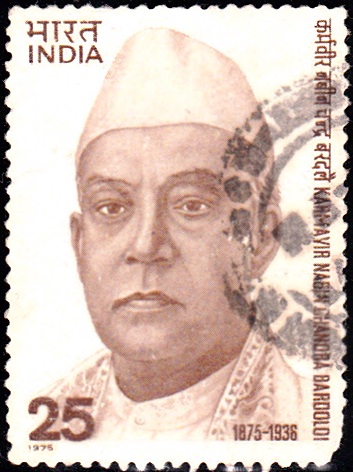
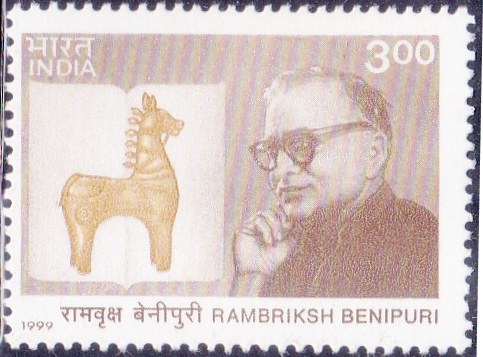
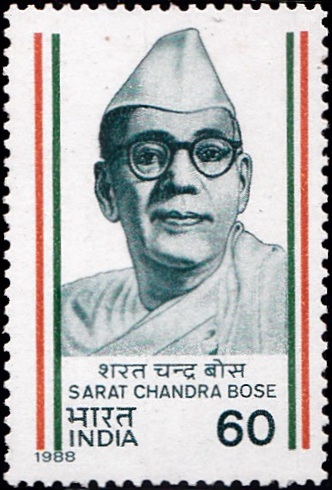
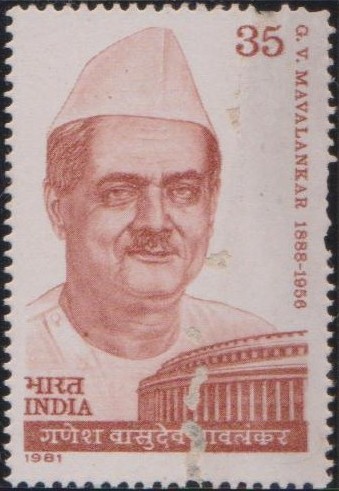
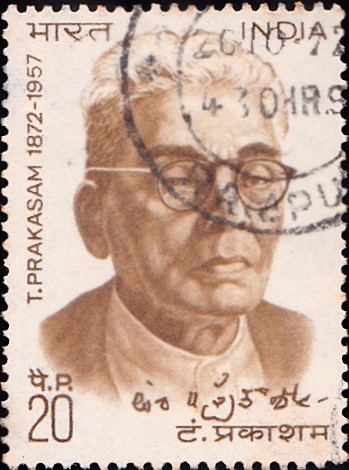
[…] 1942 and again for his participation in the Freedom Struggle in 1947, he was arrested by the Nizam. K.M. Munshi, the then Agent of India in Hyderabad state, spoke of his great contribution for the timely […]
[…] an institution dedicated to the promotion of education and culture in the country, was founded by Dr. K. M. Munshi in 1938. This institution still stands steady like a banyan tree, as ageless and tenacious as the […]